HT's HTPC, Part I
 I like to think of myself as a do-it-yourself kind of guy. I'd like to think of myself this way, but, in reality, this is not the case. I don't change my own oil (you want me to go under where?), I'm on a first-name basis with my mechanic (honestly, what Ford owner isn't?), and I call my landlord when the kitchen sink leaks (hey, that's why I pay rent). The two things I do myself are haircuts (thank you, King C. Gillette) and computers (sorry, no funny joke). I've been fascinated with computers since my parents bought me an Apple IIc in the mid-1980s. Since then, I've been modifying and building my own. A few months ago, some part of my brain came up with the idea to build a home theater PC from scratch—and make it silent. Keep in mind that this was the same part of my brain that thought it would be a tremendous idea to build a 13-foot-long subwoofer. Thanks to the deluge of e-mails I received after that piece (one—thanks, Mom) and the difficulty in finding a company that makes an HTPC (last count at CES, there were only 13,002 or so), I figured I'd design and build Home Theater's HTPC, the ugliest and quietest ever.
I like to think of myself as a do-it-yourself kind of guy. I'd like to think of myself this way, but, in reality, this is not the case. I don't change my own oil (you want me to go under where?), I'm on a first-name basis with my mechanic (honestly, what Ford owner isn't?), and I call my landlord when the kitchen sink leaks (hey, that's why I pay rent). The two things I do myself are haircuts (thank you, King C. Gillette) and computers (sorry, no funny joke). I've been fascinated with computers since my parents bought me an Apple IIc in the mid-1980s. Since then, I've been modifying and building my own. A few months ago, some part of my brain came up with the idea to build a home theater PC from scratch—and make it silent. Keep in mind that this was the same part of my brain that thought it would be a tremendous idea to build a 13-foot-long subwoofer. Thanks to the deluge of e-mails I received after that piece (one—thanks, Mom) and the difficulty in finding a company that makes an HTPC (last count at CES, there were only 13,002 or so), I figured I'd design and build Home Theater's HTPC, the ugliest and quietest ever.
But It's a Dry Heat
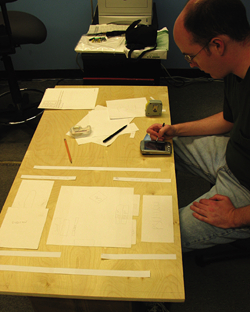 There are two forces conspiring against anyone who wants to build a quiet HTPC: heat and noise. There is no simple way to eliminate both (other than the far-too-easy water cooling). The coolest (temperature-wise) PC would be one with lots of fans and heat sinks, open to the elements to get plenty of ventilation, which would spew its noise everywhere. The most silent PC would be a sealed one, cooking the delicate internal components to a tasty silicon mucus halfway through your first movie. Several companies are making cases that use heat sinks similar to those on high-end amps, but these tend to be an expensive solution. So how do you make a case with adequate cooling (lots of air movement) and quietness (lack of air turbulence, compression, and rarefaction)?
There are two forces conspiring against anyone who wants to build a quiet HTPC: heat and noise. There is no simple way to eliminate both (other than the far-too-easy water cooling). The coolest (temperature-wise) PC would be one with lots of fans and heat sinks, open to the elements to get plenty of ventilation, which would spew its noise everywhere. The most silent PC would be a sealed one, cooking the delicate internal components to a tasty silicon mucus halfway through your first movie. Several companies are making cases that use heat sinks similar to those on high-end amps, but these tend to be an expensive solution. So how do you make a case with adequate cooling (lots of air movement) and quietness (lack of air turbulence, compression, and rarefaction)?
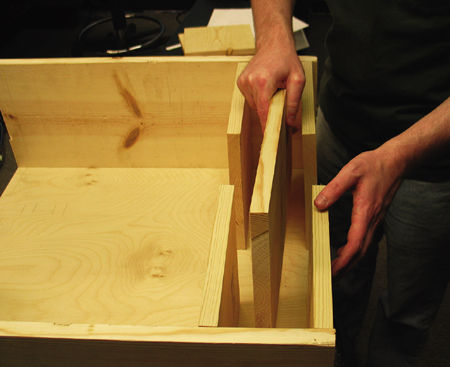
Two Types of Noise
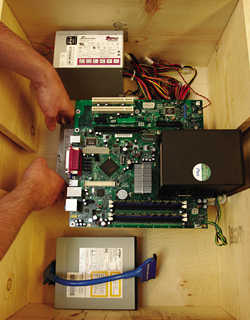 In a computer case, the noise culprits fall into two main categories: sympathetic and direct. Noise caused by sympathetic vibrations is the easier one to deal with. Isolating hard and disk drives isn't difficult, especially when you're building your own case. Using rubber to place in between the drive and the outside of the case pretty much does it. Directly produced noise, on the other hand, is harder to deal with. It comes from a number of sources and is difficult to quell. You can reduce DVD, hard-drive, and power-supply noise by buying quiet models of each part, but even quiet parts still add up. If you have four 30-decibel, uncorrelated noise sources in a case, these sum together to a total of about 42 dB. (I'll talk more about this next month.) A major source of directly produced noise really blows—the large number of fans in today's computers creates quite a racket. To get the hot air out of the case and draw cool air in, fans are placed at the back of a case and often in the front, as well. As processors, chipsets, and video cards have increased in clock speed, they too have added their own fans to the mix. My computer at home has 10 fans. I am so cool. (Look, a pun!) You can buy thermostats that will only let the fans run when the case and/or chip temperature goes above a certain point. (Many modern motherboards do this automatically.) During a movie, though, the computer will likely be heating up and making a fair bit of noise. So all these things make noise, and, in a regular case, this just radiates out into the environment. In an office, it blends in with the rest of the din (like your co-workers). In a quiet home theater, you could mistake it for a Cessna. The first step is to reduce the overall noise.
In a computer case, the noise culprits fall into two main categories: sympathetic and direct. Noise caused by sympathetic vibrations is the easier one to deal with. Isolating hard and disk drives isn't difficult, especially when you're building your own case. Using rubber to place in between the drive and the outside of the case pretty much does it. Directly produced noise, on the other hand, is harder to deal with. It comes from a number of sources and is difficult to quell. You can reduce DVD, hard-drive, and power-supply noise by buying quiet models of each part, but even quiet parts still add up. If you have four 30-decibel, uncorrelated noise sources in a case, these sum together to a total of about 42 dB. (I'll talk more about this next month.) A major source of directly produced noise really blows—the large number of fans in today's computers creates quite a racket. To get the hot air out of the case and draw cool air in, fans are placed at the back of a case and often in the front, as well. As processors, chipsets, and video cards have increased in clock speed, they too have added their own fans to the mix. My computer at home has 10 fans. I am so cool. (Look, a pun!) You can buy thermostats that will only let the fans run when the case and/or chip temperature goes above a certain point. (Many modern motherboards do this automatically.) During a movie, though, the computer will likely be heating up and making a fair bit of noise. So all these things make noise, and, in a regular case, this just radiates out into the environment. In an office, it blends in with the rest of the din (like your co-workers). In a quiet home theater, you could mistake it for a Cessna. The first step is to reduce the overall noise.
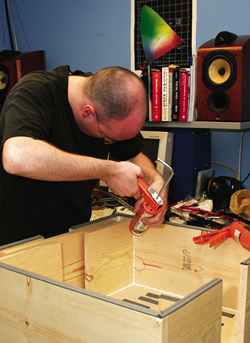 Intel to the Rescue?
Intel to the Rescue?
Advanced Technology Extended (ATX) is a list of specifications for motherboard and case design, to ensure some semblance of compatibility amongst computers. (It's comparable to maintaining the automatic-transmission order P-R-N-D and the gas pedal on the right in a car.) As far as airflow goes, however, it's a mess. The newest motherboard and case form factor is called Balanced Technology Extended (BTX). It is a significant leap forward in making cases quieter by requiring fewer fans. In a well-designed BTX case, you often only need two fans. This is because the main fan, mounted in front of the CPU, blows across the CPU heat sink, over the video card (if you use the one on board), and out the back of the case. Smooth airflow (and good cable management) means that the main fan—and the one on the power supply—can cool the entire case.
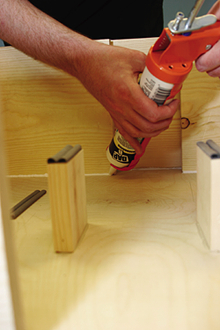 So Why Build Your Own, Genius?
So Why Build Your Own, Genius?
As quiet as store-bought cases are, there will still be noise. So how about making a case with no aesthetic or mass-market concerns? Sounds like a job for Home Theater magazine.
The first concern is that the case itself doesn't transfer any sound. A dense wood or MDF would be ideal. For cost and ease of use, I picked oak plywood for the top and bottom and pine for the sides and "muffler." Ah yes, the muffler. High frequencies don't like to bend corners. With three 90-degree bends (see picture on page 36), all the frequencies, down to a point, would be mostly trapped inside the case. You could reduce or increase this point depending on the size of the air channels within the muffler. That was the theory, anyway; no one could tell me whether or not it would actually work. I built it anyway. The pictures show you the step-by-step process, but, to sum up, I glued and nailed the case together and sealed it up with caulk. The top would have to open to gain access to the DVD player, so the top edges, as well as every component inside the case, would rest on rubber weather stripping. After a lengthy install of XP Pro and the formatting of the dual 300-gigabyte drives, the computer ran. As you can imagine, this surprised the hell out of me.
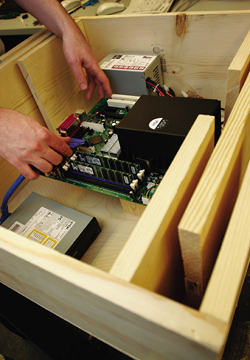 So Does It Work?
So Does It Work?
Yes, mostly. The first issue: the heat. With the top on and the computer idling on Windows, the processor and motherboard temperatures were fine. (Side note: Intel has a temp-diagnostic program for their motherboards that allows you to monitor the processor and two motherboard location temperatures from within Windows. It's a very useful program.) After running a movie for three hours, the processor temperature was fine, but the motherboard temps were a little higher than I would have liked. Also, many items within the case were a little hot to the touch, and the processor fan had kicked up from a leisurely 1,000 RPM to a more frantic 3,000 RPM. Nothing was too dangerous, but heat equals bad. First up for Part II is an additional case fan. The extra noise at idle will be worth the reduction in case temperatures and possibly the reduction in speed of the main fan when the temps are up.
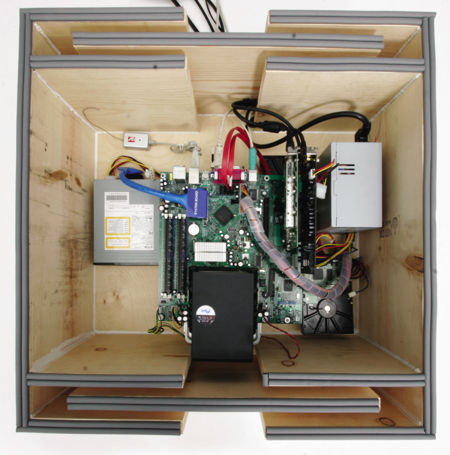
The sound side of things was far more successful. With the top open and the computer at idle, I measured 47 dB "A"-weighted 6 inches from the center of the motherboard. With the top closed, I measured 42 dB at the opening closest to the fan and 39 dB at the other opening. Hey, stop laughing. That's pretty good for no other noise reduction. With a DVD going, I measured 43.5/41 dB at the respective openings and 48.5 dB with the top off. What is more important than the actual decibel reduction is the reduction of certain frequencies. The fan, usually churning at around 1,000 RPM, was barely audible, but the air it pushed across the motherboard was not audible at all. The only other sound that you can really hear is the DVD drive, and this isn't any louder than a regular DVD player. So it went from a broad-spectrum sort of white noise to a more ignorable two-frequency, low-level hum.

Success?
On one level, I'm pleased with these results (as in, it works). On another level, I'm a little disappointed. Playing a DVD in a quiet room, the Frankenputer is as quiet as any other piece of equipment that makes noise in your system. It is far, far quieter than any projector or anything else with fans. But I can still hear it, so it's not quiet enough. Next month, I'll make it even quieter, increase its functionality with some software, and talk more about hardware. Until then, I will spend my days playing video games in our studio. Work is tough.
Equipment list:
Intel D915GMH BTX Motherboard
Intel 3.6 GHz Pentium 4 Processor
SoundBlaster Audigy 4 Sound Card
Kingston KVR400X64C3AK2 512-MB (2) RAM
Maxtor DiamondMax 10 300-GB Drive (2)
TDK Indi 1280-B 12x+/8x Multiformat
DVD Burner
ATI HDTV Wonder ATSC/NTSC Tuner Card
Broadcast Flag Alert
If you're interested in building your own home theater PC, you might want to buy the HDTV tuner card before July 1. Why? The FCC has ordered that, as of July 1, any product containing an ATSC tuner—be it a standalone tuner, integrated HDTV, or HDTV tuner card—must recognize the broadcast flag.
The flag is simply a digital code embedded in over-the-air DTV broadcasts that signals the tuner to limit the indiscriminate redistribution of the content. The FCC's goal is not to limit a consumer's ability to make personal copies of over-the-air content. The flag is designed to prevent people from taking that copied content and dropping it on a peer-to-peer network for mass downloading over the Internet.
HTPCs, with their open platforms and broadband abilities, can often redistribute this content with greater ease and will likely be more affected by the flag's implementation than general home theater devices. Companies will no longer be able to manufacture their existing HDTV tuner cards after July 1, although retailers will be able to sell existing tuners until they run out of stock. That means the HDTV Wonder that Geoffrey used here will soon be unavailable. ATI has not officially announced a new flag-compliant tuner card, but they do plan to offer one in the future. You'll still be able to build an HTPC after July 1. You just won't have carte-blanche control over the digital content you receive over the air. All existing equipment manufactured before July 1 will continue to function exactly as it does now; so, if you don't want to worry about these issues (at least for a while), go shopping before July 1.
Tune in next month for a more in-depth explanation of the broadcast flag and its effect on home theater products.—Adrienne Maxwell








































